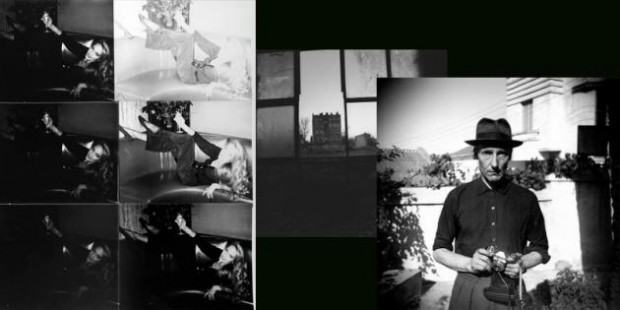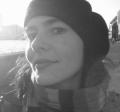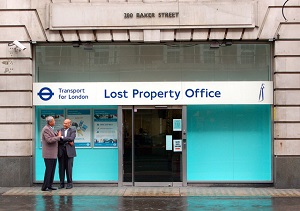You have no items in your cart. Want to get some nice things?
Go shopping
David Lynch, William S. Burroughs and Andy Warhol have all used images and language to encapsulate massive cultural moments in American art and literature. They have all fertilized and fed on American life and culture: Lynch with his films of dystopian suburbia, replete with severed ears embedded in perfectly manicured Day-Glo lawns; Burroughs for his altered states which enabled a new way of writing in which meaning flowed as much from the process as the content; and Warhol for his death-of-the-artist approach to making art that embraced mass production and reproduction. In a coup for the small venue, London’s Photographers’ Gallery is displaying the work of each cultural icon in separate but parallel exhibitions.
On the fifth floor is the work of the only living photographer of the three: David Lynch. In tandem with his career as a filmmaker, Lynch has always taken photographs, often as part of his location scouting. His subject matter consists of abandoned factories and post-industrial landscapes. His palette is made up of shades of grey which is at odds with his more recent films in which colour is an important formal component. Who can forget the saturated hues of Blue Velvet or Mulholland Drive? The landscapes here are more akin to those of the earlier Eraserhead and The Elephant Man.
The smudgy charcoal textures in the silver gelatin prints embody a sense of nostalgia by recalling classical photography of the pre-digital era — these are the same silvery tones as W. Eugene Smith’s miners, Bruce Davidson’s Lower East Side and Walker Evans’s shop signs. There is also something of Bernd and Hilla Becher in these imposing structures, though I sense Lynch is more interested in atmosphere than he is in any kind of systematic documentation. Although there is a formal beauty and elegance in these photos, they feel anachronistic and backward-looking: I have wandered these barren landscapes before.
This body of eighty photos taken in Poland, Germany, the UK and the US span the decades from 1980 to 2000. When Lynch photographed these empty cathedrals, mines in the UK were closing and in the US car plants were shutting down. Maybe Lynch is lamenting — for there is melancholia attached to these decaying spaces — the end of a certain kind of production, when we stopped making actual physical things and replaced reality with a virtual one of noughts and ones. I was trying to peer beyond the empty shapes and textures, and the eerie atmospheres of these images, and yet ultimately what I came up with was more emptiness and not much else.
Down one flight from Lynch are dozens of photos by the Beat novelist, essayist and spoken-word performer William S. Burroughs. Abstract shots from his window in Tangier are the size of calling cards, printed on thick, creamy photo paper with decaled edges. They are romantic, fetishistic objects that conjure an era long gone. There is a range of subject matter here: flowers stuck unceremoniously in Coke bottles (made in honour of his flower-arranger mother); fellow writers and collaborators Jack Kerouac and Brion Gysin; self-portraits where he appears more shadow or fragment than whole person.
Beyond the creation of these objects themselves, lies an approach to image-making that is based on cutting up, arranging, assembling and collaging. You can see the fragmented and yet focused mind of the artist working perhaps in the same way it would have in his cut-up novels which approached narrative and story as something circular and random. Images are collaged and sometimes rephotographed creating echoes through form and time as he grapples with the time-space continuum. In his search for altered realities, he created work at the edges of logic and narrative.
The scope and variety of Burroughs’s subject matter is striking. The abstract shots from windows and through ripped fences have a dream-like surrealist feel to them, whereas his documenting of a car accident in New York City seems to foreshadow the Instagram generation. There is an almost forensic quality at work here as the form drains the images of any drama. And there is humour, as seen in his series of photos of the Moka Bar on Frith Street in London. He wrote to the owners of this café complaining of rudeness and a “poisonous cheesecake”. He then photo-bombed the place by turning up every day for weeks with his camera and audio equipment, driving the customers away. The final photo in this series shows the same café but with a sign that reads “Queens Snack Bar”. Burroughs saw photography as something that could enact change. His camera was like a gun at times, and we all know what happened when he played William Tell with his second wife: she died.
A softer side of Burroughs can be seen in his What Was, What Isn’t series from 1972 in which he photographed the bed he sometimes shared with his on-off lover John Brady. The only proof of their relationship — or love or neediness — consists of a few stains on the messed up sheets. Like words, Burroughs used photographs as part of a larger project and not as ends in themselves. They are components to be rearranged and reassembled as a means to examine time and space, subject and form. In this Burroughs was and remains a true modern.
The revelation for me of these three distinct yet overlapping shows was Andy Warhol: Photographs 1976-1987. I felt I was seeing afresh an artist I thought I knew. The works in this show are black and white, and most of them are small, lending them a rare intimacy . There is some shared language between Warhol and Burroughs: abstract views from windows, humour (a school bus captured by Warhol reads “Gay Head”), a need to document the mundane and a shared back-and-forth trajectory between celebrity and the gutter. But the scale and the power of Warhol’s work hit me with a force – not the force of a Lichtensteinian WHAAM! but the force of a soft, insistent whisper.
There are no larger-than-life Marilyns, Elizabeth Taylors or Elvises here. The curator at the Photographers’ Gallery, Karen McQuaid, has instead decided to show us his much less well-known work, and in doing so she has shown us Warhol the artist rather than Warhol the celebrity-obsessed icon we thought we knew.
His People on the Street series, in which he documented his life obsessively with a point-and-shoot Minox, shows us a 1970s and ’80s in which the American dream has gone sour: filthy manhole covers, decaying suburban houses, gleaming chrome bathrooms in empty show homes, bin bags, newspaper boxes telling us what to do if there are problems with our subscriptions, hospital signs exhorting us not to stand and a slightly straggly looking gay pride march. One senses a crack in the usual Warholian façade in these photos: a black man lies face down on a bench. He may be sleeping or he may be passed out. His tiny shorts and sneakers show off a pair of long, shapely legs, which appear fragile and vulnerable. He has the body and the beauty of a Roman or Renaissance sculpture, which Warhol depicts with a strange almost elegiac beauty.
The three celebrity pieces shown here are not the usual graphic, colourized silk-screens; they are black and white. Liza Minnelli is doing a manic back bend à la Studio 54 while next to her Jean-Michel Basquiat crams what appears to be a very expensive meal into his mouth and Jerry Hall reclines vacantly on a sofa, glass of champagne in hand. This is not really the good life; it is more of a sneaky glance at the good life during a moment when the subjects have let their guard down. There is something oddly mortal about Liza, Jerry and Jean-Michel. It is as if Warhol is trying to tell us that they — like us — will also turn to dust one day. Perhaps it is the fact the images are stitched together with very fine thread, that hints at the human hand, and heart, at work here.
Warhol’s photos of his cupboards with their Hellman’s mayonnaise and packages of fig cookies have a satisfyingly banal quality. He perversely worships the faceless packaging in these photos the way he did with his Brillo Boxes and Campbell’s soup cans, and inherent in this worship is a conflating or flattening of aesthetics, meaning and class. He famously loved the fact that when the president drank a bottle of Coca Cola, he was drinking the same beverage as the junkie on the street. By examining the superficial, he shines a light into the depths of everyday objects and rarefied glamour. I could hear Warhol speaking Karl Kraus’s words: “There are women who are not beautiful but only look that way.” Warhol saw it as his job to get inside this ugly beauty and throw it back at us.
Warhol’s usual ironic distance has been broached and breached here. In this group of photos we are seeing Warhol as an American original. There is more here than his desire to be “plastic”, to be “famous for 15 minutes” or to be a “machine”. In these photos we see him doing something rare: being human. To allow us access to this version of Andy Warhol is an achievement indeed.
The Lynch, Burroughs and Warhol exhibitions continue at the Photographers’ Gallery until March 30. Tickets are £4 (£2.50 concessions). See here for more information.

About Joanna Pocock
Joanna Pocock graduated with distinction from the Creative Writing MA at Bath Spa University. She is a contributing travel writer for The LA Times, and has had work published in The Nation, Orion, JSTOR Daily, Distinctly Montana, the London Sunday Independent, 3:AM, Mslexia, the Dark Mountain blog and Good Housekeeping, among other publications. In 2017 she was shortlisted for the Barry Lopez Creative Non-fiction Prize and in 2018 she won the Fitzcarraldo Editions Essay Prize. 'Surrender', her book about rewilders, nomads and ecosexuals in the American West, will be published by Fitzcarraldo in 2019. She teaches Creative Writing, both fiction and non-fiction, at Central St Martins in London. Some of her writing can be found at: www.joannapocock.blogspot.co.uk and www.missoulabound.worpress.com




